
© Charlotte Audureau. (Click image for larger version)
Compagnie CNDC-Angers / Robert Swinston
Inlets 2, Place, How to Pass, Kick, Fall and Run
★★★★✰
New York, Joyce Theater
4 April 2017
www.cndc.fr
www.joyce.org
Nightmares and Games
It’s been a good season for Merce Cunningham in New York. First, the CCN – Ballet de Lorraine performed Sounddance during its visit to the Joyce – by far the best piece on the program. Then, Paul Taylor invited the Lyon Opera Ballet to dance Summerspace as part of its spring run at Lincoln Center, on a program with Martha Graham’s Diversion of Angels and Taylor’s own Promethean Fire. And now the Compagnie CNDC Angers – Robert Swinston is here with an all-Cunningham program. Meanwhile, the Cunningham Trust continues to present workshops of lesser-known works. Those of us who feared, when the Cunningham company shut its doors at the end of 2011, that this repertory would disappear, are breathing a sigh of relief, at least for now.
It seems significant that the three troupes who have performed Cunningham in New York so far this year have all come from France, a country that embraced the company from its first tour there, in 1964. And it is in France that Cunningham’s repertory has found a permanent home, at the Compagnie CNDC in Angers, led by the longtime Cunningham dancer, later assistant director and director of choreography, Robert Swinston.

© Charlotte Audureau. (Click image for larger version)
For its second visit to the Joyce (the first was in 2015) Compagnie CNDC brought an excellent and well-balanced program. Two works from the sixties – Place and How to Pass, Kick, Fall and Run – followed one from the eighties, Inlets 2. The moods were perfectly calibrated: A contemplative nature study followed by a piece that seemed to suggest troubled dreams. And, to sign off, a caper set to funny anecdotes by John Cage. The hour-and-a-half program was varied, brisk, surprising, and always bracingly intelligent. All qualities that make Cunningham’s work feel alive and thoroughly timeless, perhaps more so with each passing year.
Inlets 2 – as the name suggests, it is a variation upon an earlier work – is perhaps the most abstract of the three. The program explains that it employs 64 movements, whose order of appearance was decided through the use of chance operations. Even without knowing this, one senses its economy of means and resistance to easy interpretation. One is left to admire its seemingly perfect harmony, the inherently beautiful behavior of well-organized bodies going about their business, like various fauna gathered together in peaceful coexistence. Though there are echoes and moments of unison, each figure is more or less on its own. Inlets 2 is considered one of Cunningham’s nature studies for this reason, and also because the score (by John Cage) consists of water sounds, produced by three people manipulating shells of different sizes – some quite huge. At times, it’s as rewarding to listen to the shell-handlers, them pouring water from one shell to another, producing glug-glug and dribbling sounds, as it is to watch the activity onstage. Dancers stand on the tips of their toes, tilt, twist, or plié while undulating their arms like strange birds. At times they draw an arc, down and up and down again, like the sun rising and falling in the sky. The movements are clean and elegantly three-dimensional. There is a sense of perfect natural order. My only reservation concerned the costumes, originally designed by Mark Lancaster: unflattering leotards in pale colors and opaque tights that made the dancers look square.

© Charlotte Audureau. (Click image for larger version)
There aren’t as many strong personalities, at least obvious ones, in this company, not like there were in the Cunningham troupe. The dancers are, for the most part, focused and rather neutral. There’s nothing wrong with this, but it does affect one’s experience of the dances – they feel a little muted, as if held at a distance. Still, a few dancers stand out. One of these is Gianni Joseph, the central figure of Place, a role originally danced by Cunningham. Another is the striking and statuesque Claire Eigle-Goujon. In this haunting work, last performed in 1971, Joseph is an outsider, a wanderer, haunted by dreams. Mostly, he’s alone, though he has one extended, and somewhat melancholy, duet. There is a lot of partnering, unlike Intlets 2.
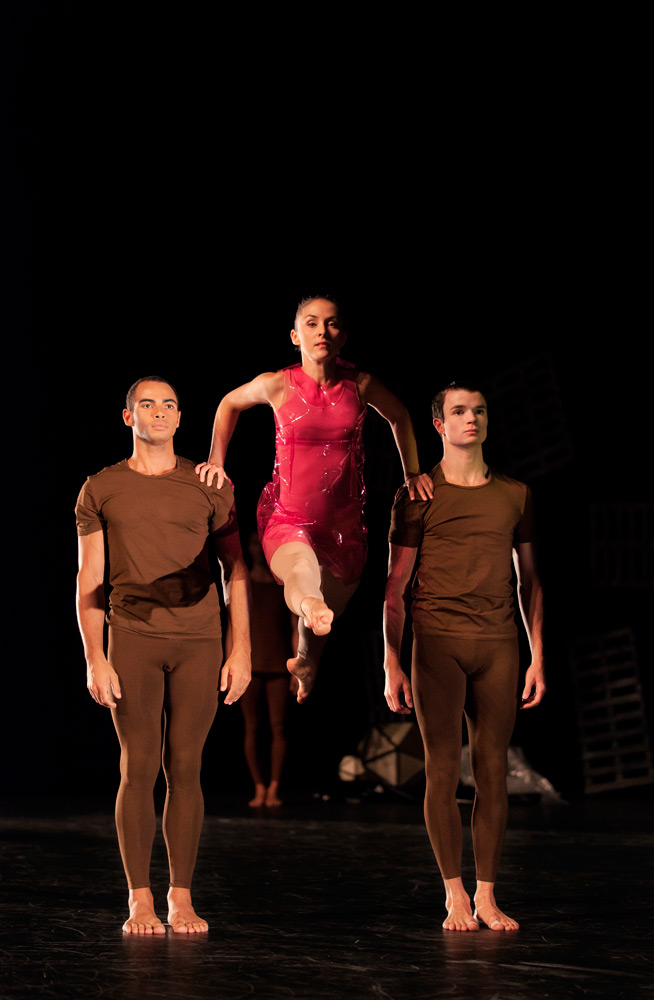
© Charlotte Audureau. (Click image for larger version)
The piece begins with Joseph, in a striking solo in which he balances on one leg and then collapses, soundlessly, onto the floor in a cross-legged pose. The speed of the transition made several people gasp, including me. He enters and then recedes from the action, almost as if the other dancers were figures in his mind. Joseph’s face communicates intensity and thought, and perhaps a slight note of fear. As he pulls a lamp slowly across the rear of the stage; a clump of dancers frozen in various poses advances with the light. Each performs a unique set of movements, repeated in various directions: a woman covers her face, another seems to play a drum while bending forward, a man does a series of fast hops. Private dramas unfold, and remain private. Later, the “protagonist” climbs into a plastic bag and thrashes around. The score, which sounds like the beeps and buzzes of a broken public announcement system, is by Gordo Mumma. Officially it is a “duo for bandoneon and computer,” but you would never know. If Inlets 2 is a nature study, Place feels like a peek into a troubled mind, theatrical in its own strange, hermetic way.
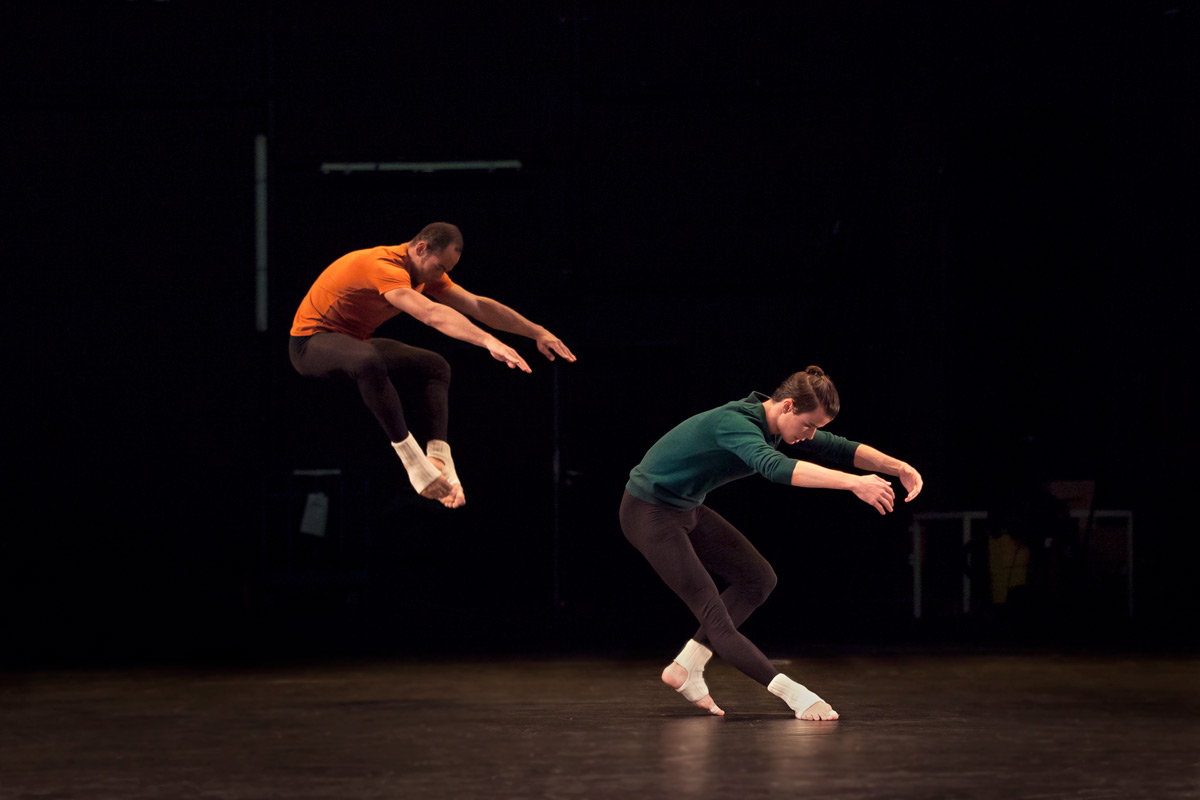
© Charlotte Audureau. (Click image for larger version)
How to Pass, Kick, Fall and Run is its opposite: extroverted, witty (if not quite as witty as it thinks it is), playful. Two narrators sit on the side of the stage and read a series of funny anecdotes, drawn from John Cage’s famous 1958 lecture Indeterminacy. Mostly, they tell stories about friends of Cage’s and Cunningham’s, or about members of Cunningham’s family. Often these stories have punch lines. In one, Cunningham’s mother asks a man she has hit with her car, “what are you doing there?” In another, the composer David Tudor tells a student interrupting his lunch, “if you don’t know, why do you ask?” The two readers, Gene Caprioglio and Laura Kuhn, speed up or slow down their words to make them fit into one-minute chunks. There are long pauses and passages when the two voices overlap, creating noise, at times confusion, at times counterpoint. Meanwhile the dancers run on and off, vigorously, athletically. The women’s hair, in pony-tails, swishes around. The look is sporty, with lots of skipping and jumping and dribbling. Two women scamper across, pulling each other forward. Meanwhile, a man in blue (Lucas Viallefond), at the center of this tourbillon of activity, moves with calm, purposeful clarity. And then, in the midst of all this activity, the curtain comes down, unsentimentally, and without fuss.
One imagines the dancers simply continuing on with their furious activities. And perhaps they will, until we see them again in a year or two. We’ll be waiting.












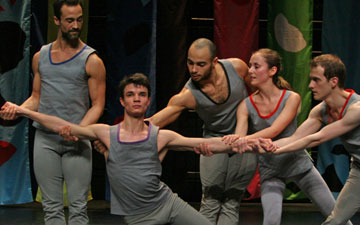
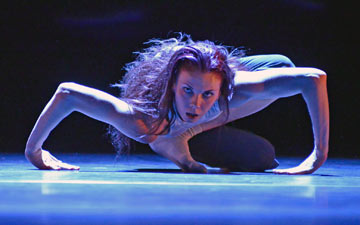
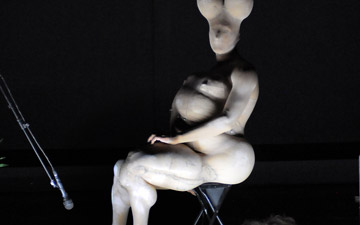
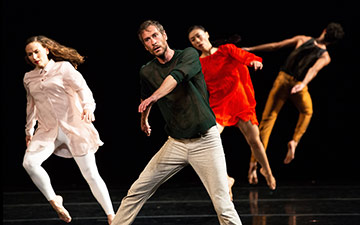
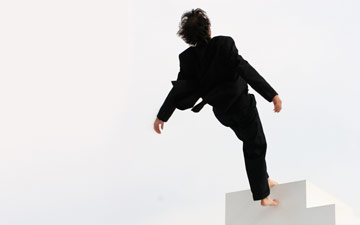
You must be logged in to post a comment.